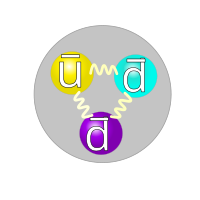 The quark structure of the antineutron. | |
| Classification | antibaryon |
|---|---|
| Composition | 1 up antiquark, 2 down antiquarks |
| Statistics | fermionic |
| Family | hadron |
| Interactions | strong, weak, electromagnetic, gravity |
| Symbol | n |
| Antiparticle | neutron |
| Discovered | Bruce Cork (1956) |
| Mass | 939.56542052(54) MeV/c2 [1] |
| Electric charge | 0 |
| Magnetic moment | +1.91 μN |
| Spin | 1/2 |
| Isospin | 1/2 |
| Antimatter |
|---|
 |
The antineutron is the
antiparticle of the
neutron with symbol
n
. It differs from the neutron only in that some of its properties have
equal magnitude but opposite sign. It has the same
mass as the neutron, and no net
electric charge, but has opposite
baryon number (+1 for neutron, −1 for the antineutron). This is because the antineutron is composed of
antiquarks, while neutrons are composed of
quarks. The antineutron consists of one
up antiquark and two
down antiquarks.
Background
The antineutron was discovered in proton–antiproton collisions at the Bevatron ( Lawrence Berkeley National Laboratory) by the team of Bruce Cork, Glen Lambertson, Oreste Piccioni, and William Wenzel in 1956, [2] one year after the antiproton was discovered.
Since the antineutron is electrically neutral, it cannot easily be observed directly. Instead, the products of its annihilation with ordinary matter are observed. In theory, a free antineutron should decay into an antiproton, a positron and a neutrino in a process analogous to the beta decay of free neutrons. There are theoretical proposals of neutron–antineutron oscillations, a process that implies the violation of the baryon number conservation. [3] [4] [5]
Magnetic moment
The magnetic moment of the antineutron is the opposite of that of the neutron. [6] It is +1.91 μN for the antineutron but −1.91 μN for the neutron (relative to the direction of the spin). Here μN is the nuclear magneton.
See also
References
- ^ "2018 CODATA Value: neutron mass energy equivalent in MeV". The NIST Reference on Constants, Units, and Uncertainty. NIST. 20 May 2019. Retrieved 2022-09-11.
- ^ Cork, Bruce; Lambertson, Glen R.; Piccioni, Oreste; Wenzel, William A. (15 November 1956). "Antineutrons Produced from Antiprotons in Charge-Exchange Collisions". Physical Review. 104 (4): 1193–1197. Bibcode: 1956PhRv..104.1193C. doi: 10.1103/PhysRev.104.1193. S2CID 123156830.
- ^ R. N. Mohapatra (2009). "Neutron-Anti-Neutron Oscillation: Theory and Phenomenology". Journal of Physics G. 36 (10): 104006. arXiv: 0902.0834. Bibcode: 2009JPhG...36j4006M. doi: 10.1088/0954-3899/36/10/104006. S2CID 15126201.
- ^ C. Giunti; M. Laveder (19 August 2010). "Neutron Oscillations". Neutrino Unbound. Istituto Nazionale di Fisica Nucleare. Archived from the original on 27 September 2011. Retrieved 19 August 2010.
- ^ Y. A. Kamyshkov (16 January 2002). "Neutron → Antineutron Oscillations" (PDF). NNN 2002 Workshop on "Large Detectors for Proton Decay, Supernovae and Atmospheric Neutrinos and Low Energy Neutrinos from High Intensity Beams" at CERN. Retrieved 19 August 2010.
- ^ Lorenzon, Wolfgang (6 April 2007). "Physics 390: Homework set #7 Solutions" (PDF). Modern Physics, Physics 390, Winter 2007. Retrieved 22 December 2009.
External links
- LBL Particle Data Group: summary tables
- suppression of neutron-antineutron oscillation
- Elementary particles: includes information about antineutron discovery (archived link)
- " Is Antineutron the Same as Neutron?" explains how the antineutron differs from the regular neutron despite having the same, that is zero, charge.